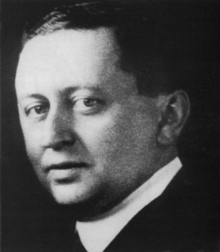Jakob Goldschmidt
Jakob Goldschmidt , (also Jacob Goldschmidt) (born December 31, 1882 in Eldagsen ; † September 23, 1955 in New York ) was a Berlin-based German-Jewish banker .
Life
His father, Markus Goldschmidt, a manufactured goods dealer in Eldagsen, and his mother Lina, née Bacharach, had six children, including Jakob. He attended school in Kassel.
Career
Goldschmidt learned the banking business from H. Oppenheimer in Hanover. In 1907 he moved to the National Bank for Germany in Berlin. Goldschmidt founded the private bank Schwarz, Goldschmidt & Co. in 1909 together with Julius Schwarz . In 1918, at the suggestion of the banker Carl Hagen and Louis Hagen's brother-in-law , Bankhaus A. Levy & Co. - he joined the board of directors of the National Bank for Germany in 1922 the Darmstädter Bank for Commerce and Industry merged to Darmstädter und Nationalbank (Danat-Bank) , of which he became the sole partner. As one of the most dynamic and unconventional major bankers of his time, Goldschmidt held up to 123 supervisory board mandates , including at Ufa, founded in 1917, and IG Farben (1931–1932).
At Danat-Bank, Goldschmidt ousted the more conservative Hjalmar Schacht . Schacht left the bank in 1923 due to differences with Goldschmidt and became President of the Reichsbank in the same year .
In 1931, the Danat-Bank became insolvent after loan defaults as a result of balance sheet falsification by the North German wool combing & worsted spinning mill and speculative losses of the Danat-Bank, for which Goldschmidt was responsible. Subsequently, the entire German banking system fell into a deep crisis and Goldschmidt lost his post as CEO of Danat-Bank.
In 1933 he lost his private villa in Neubabelsberg on Griebnitzsee in Virchowstrasse. 43 . While maintaining his Berlin residence at Hitzigstr. 7 he moved to Switzerland and emigrated to the USA in 1934. There he held a number of supervisory board mandates, including at the Manitoba Sugar Company .
Other engagement
In the 1920s he joined the Society of Friends .
Goldschmidt was senator of the Kaiser Wilhelm Society from 1930 to 1933 and a member of the initiative committee of the German-language Encyclopaedia Judaica . He financed the purchase of Vincent van Gogh's painting Garten von Daubigny by the Nationalgalerie Berlin and in 1927 donated the Sophie Goldschmidt girls' home in memory of his wife .
Also in 1927 he received an honorary doctorate from the universities of Heidelberg and Berlin.
Lawsuit for compensation and redress
In 1953, Jakob Goldschmidt failed with a lawsuit for compensation of 5.3 million Deutsche Mark, first against Dresdner Bank and then for reparations against the Federal Republic of Germany . The Berlin Regional Court dismissed his lawsuit against the state since
“In this case, in truth, the reparation of National Socialist injustice was not sought at all [...], because Goldschmidt had brought about the collapse of the Danat Bank through his extremely daring investments [...]; this signaled the beginning of the great economic crisis in Germany, which ultimately paved the way for Hitler. [...] The restitution laws are not enacted to make up for losses of assets that had nothing to do with the Third Reich at the taxpayer's expense. "
family
Jakob Goldschmidt had several siblings, one brother was Julius Goldschmidt (1884–1936), the ADREMA addressing machine manufacturer . Jakob was married to Sophie, b. Joseph. There was a son from the marriage, Alfred Erwin.
literature
- Michael Jurk: Jakob Goldschmidt. On the life and work of a Jewish banker 1882–1955. Master's thesis at the University of Mainz. Mainz 1984.
- Gerald D. Feldman : Jakob Goldschmidt, the history of banking crisis of 1931 and the problem of freedom of maneuver in the Weimar economy. In: Torn Interwar Period. Economic history contributions. Festschrift for Knut Borchardt. Baden-Baden 1994, p. 307ff.
- Gerald D. Feldman: Jewish bankers and the crisis of the Weimar Republic (= Leo Baeck Memorial Lecture. Volume 39). New York 1995.
- John F. Oppenheimer (Red.) And a .: Lexicon of Judaism. 2nd Edition. Bertelsmann Lexikon Verlag, Gütersloh u. a. 1971, ISBN 3-570-05964-2 , col. 249.
- Hans-Christian Rohde: We are Germans with a Jewish religion. History of the Jews in Eldagsen and Springe, Bennigsen, Gestorf, Völksen (= Hallermunter Schriften. 2). Museum auf dem Burghof, Springe 1999. pp. 40–41.
Web links
- Sophie Goldschmidt girls' home
- About the Goldschmidt villa in Potsdam
- Jacob Goldschmidt's social policy , article in the Vossische Zeitung , April 9, 1929.
- Newspaper article about Jakob Goldschmidt in the 20th century press kit of the ZBW - Leibniz Information Center for Economics .
Individual evidence
- ^ Jens Ulrich Heine: Board of Directors & Destiny, page 271, VCH Verlagsgesellschaft, Weinheim 1990
- ↑ a b Jens Ulrich Heine: Management Board & Destiny, page 270, VCH Verlagsgesellschaft, Weinheim 1990
- ^ John Weitz: Hitler's Banker - Hjalmar Schacht. Europa, Munich, Vienna 1998, ISBN 3-203-84003-0 , p. 94.
- ↑ HaDrB, inventory 125th Nuremberg Trial, file 13929-2000, memo v. October 29, 1949
- ↑ Klaus-Dietmar Henke : The Dresdner Bank in the Third Reich (1. The debt problem, page 359, Oldenbourg)
- ↑ Christoph Neßhöver: Germany's biggest banking crises, 2nd part: 1931: Danat-Bank - nationalization by Brüning manager-magazin.de of January 24, 2013
- ^ Jens Ulrich Heine: Board of Directors & Destiny, page 272, VCH Verlagsgesellschaft, Weinheim 1990
- ^ Karl Lattmann: Goldschmidt, Julius. In: New German Biography (NDB). Volume 6, Duncker & Humblot, Berlin 1964, ISBN 3-428-00187-7 , p. 616 f. ( Digitized version ).
| personal data | |
|---|---|
| SURNAME | Goldschmidt, Jakob |
| BRIEF DESCRIPTION | German banker |
| DATE OF BIRTH | December 31, 1882 |
| PLACE OF BIRTH | Eldasen |
| DATE OF DEATH | September 23, 1955 |
| Place of death | New York City |
